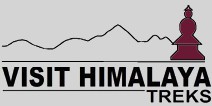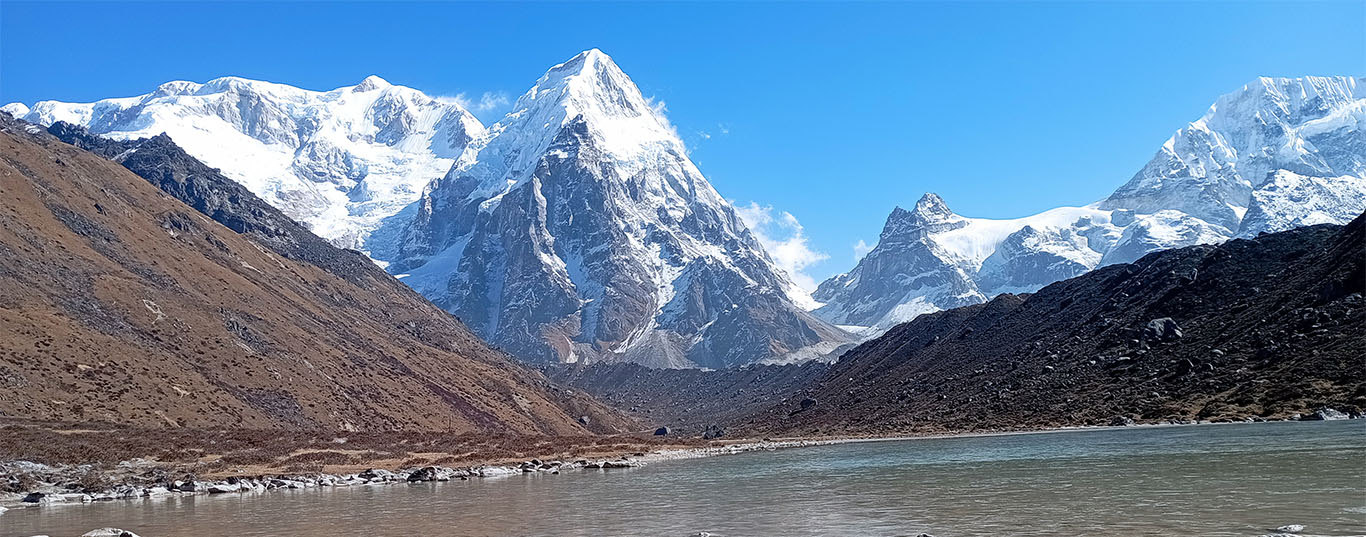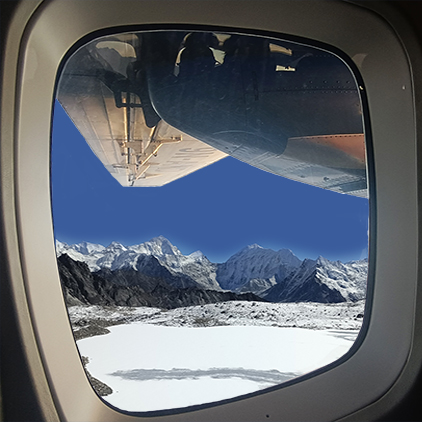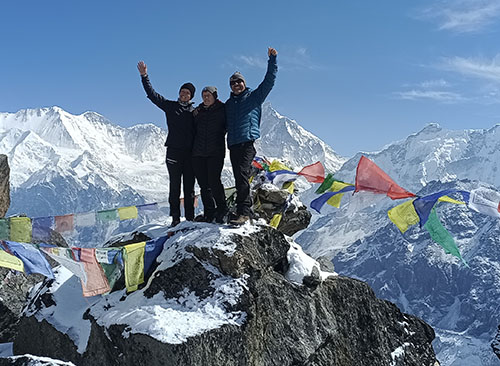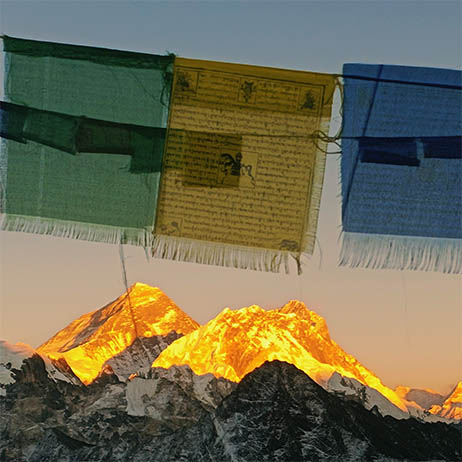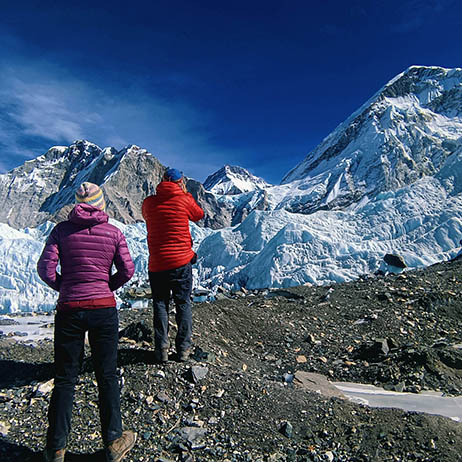The Kanchenjunga Base Camp Trek is one of the most remote, untraveled, and rewarding trekking routes in Nepal. Located in the far eastern corner of the nation, this challenging route takes you into uncharted wilderness, remote mountain settlements, and to the base camp of the world's third-highest peak, Mt. Kanchenjunga (8,586 meters). As compared to more touristy routes such as Everest or Annapurna, the Kanchenjunga region remains somewhat virgin territory for mass tourists. This not only provides the trek as a scenic experience but also a culturally stimulating and off-the-beaten-track one.
But with such seclusion, there come logistical challenges, and that is what is reflected in the cost of the trek as a whole. From multiple internal flights and private jeep transfers to restricted area permits and quality guides, the Kanchenjunga trek is something of a planning challenge. That's why most trekking groups prefer to work with established companies like Visit Himalaya Treks, who organize it all for them, from permits and accommodations to porters and guide support.
In this blog post, we're going to introduce all that you'd like to know about the Kanchenjunga Base Camp Trek Package Cost, what's included, what's excluded, where your money actually ends up, and why this once-in-a-lifetime experience is worth every rupee. Regardless of whether you're traveling alone or in a group, this cost guide shall acquaint you with what to anticipate in terms of expense and plan accordingly for this phenomenal Himalayan adventure.
1. How much does the Kanchenjunga Base Camp Trek cost?
The Kanchenjunga Base Camp Trek costs between $2,050 and $5000 per person for a 26-day all-inclusive tour. The cost depends on when you trek, the size of your group, the level of service (standard or premium), and whether you go on private or group departures. Compared to more commercialized treks like Everest Base Camp or Annapurna Circuit, Kanchenjunga is logistically more demanding as it is located in a very remote part of eastern Nepal with inferior infrastructure. This remoteness is also translated into higher transport and porterage costs.
Most full-board trekking packages, including those offered by Visit Himalaya Treks, include comprehensive services for a convenient and safe journey in this remote region.
The package cost usually includes:
All necessary trekking permits, including:
- Kanchenjunga Restricted Area Permit.
- Kanchenjunga Conservation Area Project (KCAP) Permit.
- TIMS card (Trekkers' Information Management System).
- English-speaking, government-licensed trekking guide with high-altitude experience.
- Porter services (normally 1 porter for 2 trekkers).
- All domestic transport, including:
- Round-trip flight between Kathmandu and Bhadrapur.
- Private jeep transfers from Bhadrapur to Suketar and return.
- Three meals a day (breakfast, lunch, dinner) on trek.
- Tea house or lodge accommodation during the trekking days.
- Accommodation in a hotel in Kathmandu and Ilam/Kanyam (3 nights in Kathmandu, 1 night in Kanyam normally).
- Kathmandu full-day sightseeing with a guide and transport.
- Food, salary, transport, and insurance of the guide and porter.
- Assistance guide group sizes of more than 4 people for better care.
- All applicable taxes, company service charges, and logistics.
What's usually not included in this cost:
- Nepal visa fee (at the airport upon arrival).
- International flights to and from Kathmandu.
- Lunches and dinners in Kathmandu before/after the trek.
- Personal gear, apparel, and trekking equipment.
- Bottled water, snacks, alcoholic drinks, and hot showers.
- Travel insurance (emergency evacuation should be covered).
- Guide, porter, and driver tips.
- Optional expenses (battery charging, internet/WiFi, donations, etc.)
Note: The cost will increase slightly for small groups, solo trekkers, or those who request single supplement rooms or luxury lodge upgrades.

Embark on a trek to Kanchenjunga Base Camp through the Simbuwa Khola Valley.
2. Permits for Kanchenjunga Base Camp Trek.
Since Kanchenjunga Base Camp exists in a restricted area of the eastern sector of Nepal and traverses protected areas of conservation, mountaineers need to acquire various permits so that they can access the trek legally. All of these permits are controlled strictly in such a manner that they assist in preserving the natural world, safeguarding indigenous cultures, and encouraging responsible tourism development in this remote Himalayan region.
All the permits are to be applied for via a registered trekking agency, and it is not permissible to trek independently. A minimum of two trekkers and a licensed guide are required in order to obtain the restricted area permit.
The following is the breakdown of the permits and the fees:
i. Kanchenjunga Restricted Area Permit (KRAP)
This is the main permit needed for trekking in the restricted part of the Kanchenjunga area, particularly between Tapethok and Yamphuding villages in Taplejung District.
Permits Cost:
- USD 20 per person per week.
- Valid for seven days.
- Another USD 20 per person is paid for every additional week.
- The fee is quite affordable compared to other restricted areas like Upper Mustang, Upper Dolpo, yet the permit still encourages responsible and sustainable trekking in sensitive border areas.
ii. Kanchenjunga Conservation Area Permit (KCAP)
Since most of the trek of Kanchenjunga falls under the Kanchenjunga Conservation Area Project (KCAP), this permit is required to encourage conservation, local development, and upkeep of the trails.
- Cost: NPR 2,000 per individual (around USD 16–18)
- Expires during the course of the trekking season.
- No seasonal variation.
- This fee goes solely towards the preservation of biodiversity and community-based tourism in the region.
Visa and Travel Document Matters.
Apart from trekking permits, foreign nationals must obtain a Nepal Tourist Visa. This may be done:
Upon arrival at Tribhuvan International Airport (TIA) in Kathmandu
Or beforehand at a Nepalese embassy or consulate
Nepal Tourist Visa Fees:
- 15 Days: USD 30
- 30 Days: USD 50 (most trekkers prefer this for flexibility)
- 90 Days: USD 125
Important Notes About Permits.
- Permits are non-refundable and non-transferable.
- Hard copies of permits must be carried and shown at multiple checkpoints en route.
- Trekkers group of two or more, accompanied by a government-approved guide.
- Permits must be booked through a registered trekking agency, e.g., Visit Himalaya Treks, which organizes all formalities on your behalf.
3. Porter and Guide Charge for Kanchenjunga Base Camp Trek.
Why is it necessary to hire a guide?
The Kanchenjunga area falls within a Restricted Area of Nepal, as it is made so because it is far-flung, has a sensitive border with India and Tibet, and tourism has to be controlled to preserve native cultures and delicate habitats. Hence, trekking alone is not allowed.
To reach and trek to the Kanchenjunga area, all trekking should be conducted with the presence of:
- A government-certified trekking guide.
- At least one other registered trekker (you must trek in a group of two or more).
These regulations are enforced by the Nepal Government and are made to:
- Avoid safety and rescue readiness risks in far remote, high-altitude areas.
- Promote sustainable tourism and create local jobs.
- Avoid risks related to altitude sickness, weather conditions, and navigation.
A professional and trusted operator like Visit Himalaya Treks arranges your permit, guide, and porter arrangements as per government regulations.
Hiring a Licensed Guide Cost.
- An English-speaking, experienced Kanchenjunga trekking guide will usually cost between:
- USD 30 to USD 40 per day.
- For a 26-day trek, this equates to your guide's expense being:
- USD 660 to USD 880 total, varying with experience and route difficulty.
What does the guide do?
- Navigation assistance of the trail and keeping everyone safe.
- Acclimatization assistance and management of altitude sickness hike and guide to trekkers on side trips.
- Translation and cultural information.
- Accommodation and food arrangements at teahouses.
- Assistance in emergencies (e.g., evacuating a person).
Porter Hiring Cost.
Due to the length and remoteness of the Kanchenjunga trek, hiring a porter is highly recommended.
Porter cost per day:
- USD 20 to USD 25
- For the whole duration, the whole porter charge would be:
- USD 480 to USD 650, for two trekkers (as one porter usually carries between 25 kg for two persons)
Why do you need a porter?
- Removes physical pressure from tiring and altitude-high days.
- As an advantage of saving energy, it brings more trekking delight and safety.
- Supports the local economy, as most porters are locals.
Tipping Culture in Nepal.
While tipping is not obligatory, it is greatly appreciated and socially encouraged in Nepal's trekking industry. It is a small way of saying thanks for your support staff's hard work, especially in an out-of-the-way and physically demanding trek like Kanchenjunga.
Typical tipping guidelines (per trekker):
- Guide: USD 100-150 per 3+ week trek
- Porter: USD 80-120
Tips are typically left at the end of the trek, either privately or as a group farewell dinner. It is considerate to leave the tip with a smile and gratitude, little things that mean a lot.
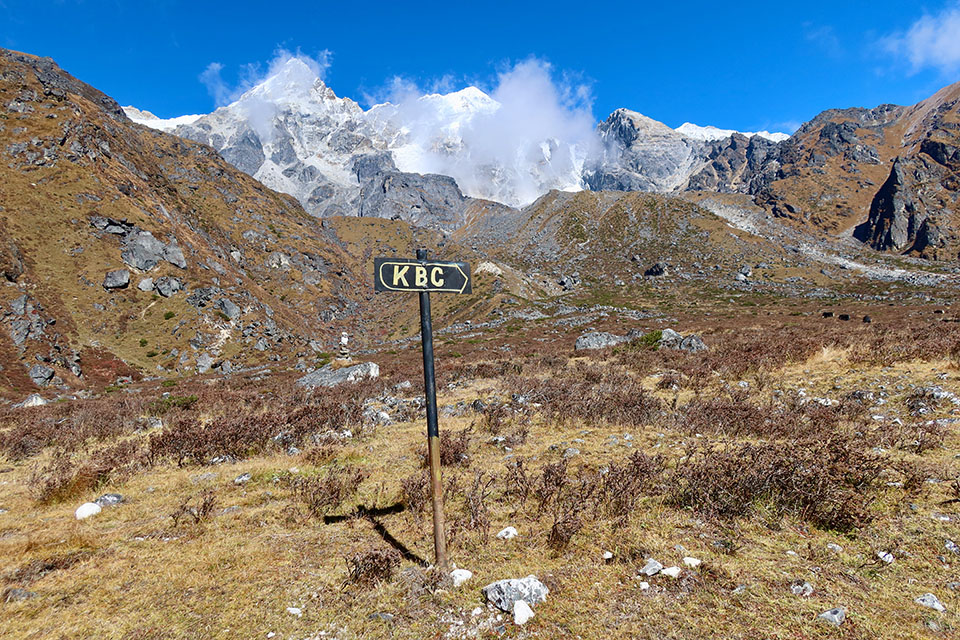
Following the well-marked sign, trek to Kanchenjunga Base Camp.
4. Food and Accommodation Cost on the Kanchenjunga Base Camp Trek.
Quality of Tea Houses On the Kanchenjunga Route?
The Kanchenjunga Base Camp Trek is one of the most remote and off-the-beaten-path treks in Nepal. Because of its remoteness and lesser tourist activity compared to the Everest or Annapurna regions, the infrastructure is minimal but functional.
You'll be sleeping in tea houses or lodges, which are simple, family-run buildings that offer food and shelter. Further up, services get lower in quality and availability. Here's what you can expect:
- Wooden or stone beds, foam mattresses, blankets, and pillows in twin-sharing rooms.
- Shared toilet facilities, usually outside the rooms. (Squat type is more common)
- Dining halls are usually heated by a firewood stove.
- Solar light or minimal electricity. (Charging can be an extra expense)
- No telephone signals or WiFi in most places above Ghunsa.
- No attached toilets or hot showers at higher altitudes. (They can be included with an extra expense at mid-altitude places)
In villages like Taplejung, Ghunsa, or Kambachen, the teahouses are quite well-equipped. At higher altitudes towards Tseram, Ramche, Lhonak, and Pang Pema, the accommodations are very basic and even more or less like campsites.
Cost of Food and Beverages Per Day.
Food is costlier in Kanchenjunga compared to other famous trekking areas due to:
- Harsh transportation (all is carried by mules or porters)
- Unavailability of supplies at higher elevations.
- Isolation and fewer trekker groups.
You would be spending between USD 35 and USD 40 per day on food and beverages. This would usually include:
- Three meals a day (breakfast, lunch, and dinner)
- Simple vegetarian foods like dal bhat (lentils and rice), noodles, momos, or Tibetan bread
- Hot drinks (tea, coffee, or soup)
- Filtered or boiled water that may be charged extra per liter.
Here's a rough breakdown:
- Breakfast: USD 8–10 (porridge, Tibetan bread, eggs, tea)
- Lunch & Dinner: USD 12–15 each (dal bhat, noodles, thukpa, curry)
- Hot drinks: USD 2–4 per cup.
- Refillable water or snacks: USD 2–3.
Food quality is good, but options become very limited at high-altitude sites such as Lhonak, Pang Pema, Sele La, Ramche, and Tseram.
Optional Upgrades or Alternatives.
- Pre-arranged camping treks with their own staff and cook can offer more varied meals and better nutrition.
- Some people prefer to take light snacks, energy bars, or packets of tea leaves from Kathmandu to supplement teahouse food.
By trekking with a fixed operator like Visit Himalaya Treks, your accommodation and meals are usually included in the overall price, so it is easier to budget and not have to worry about rising costs along the way.
5. Transportation Cost to and from the Kanchenjunga Base Camp Trailhead.
How to Reach the Start Point of the Kanchenjunga Trek?
Reaching the trailhead of the Kanchenjunga Base Camp Trek requires a mix of domestic flights and jeep rides, taking several hours as the region is remote eastern Nepal, close to the Indian and Tibetan border. The logistics are more complex and expensive than most other Nepalese treks, and this is something that is accounted for in the price of the package overall.
Common Route and Costs.
i. Kathmandu to Bhadrapur (Flight)
You begin with a domestic flight from Kathmandu to Bhadrapur, which is in the lowlands (Terai) of southeastern Nepal.
- Cost: Approximately USD 120–130 one-way, depending on season and availability.
- Duration: Around 45–50 minutes.
ii. Bhadrapur to Taplejung/Kanyam (Drive)
From Bhadrapur, a private jeep transports you up to Kanyam and then to Taplejung, Suketar, or Ranipul, the starting point of the trek.
The road is narrow, twisty, and scenic, rising through tea plantations and wooded hills.
- Cost: Around USD 300–350 (one-way jeep rental), can be shared among 4–6 trekkers.
- Duration: Takes about 10–12 hours.
iii. Return Trip from Ranipool, Suketar, or Taplejung to Bhadrapur.
After completing the trek, you’ll again take a private jeep from Ranipul or Taplejung back to Bhadrapur, then fly back to Kathmandu.
This part of the journey retraces the inbound route.
- Cost (Return Jeep + Flight): Roughly USD 300–350 total per person, depending on the group size and season.
Why Private Jeeps Are Used?
Due to the limited accessibility and dilapidated road system in eastern Nepal, public transport is not practical and not convenient for this journey. Private jeeps provide greater security, flexibility, and schedule, especially considering weather interferences.
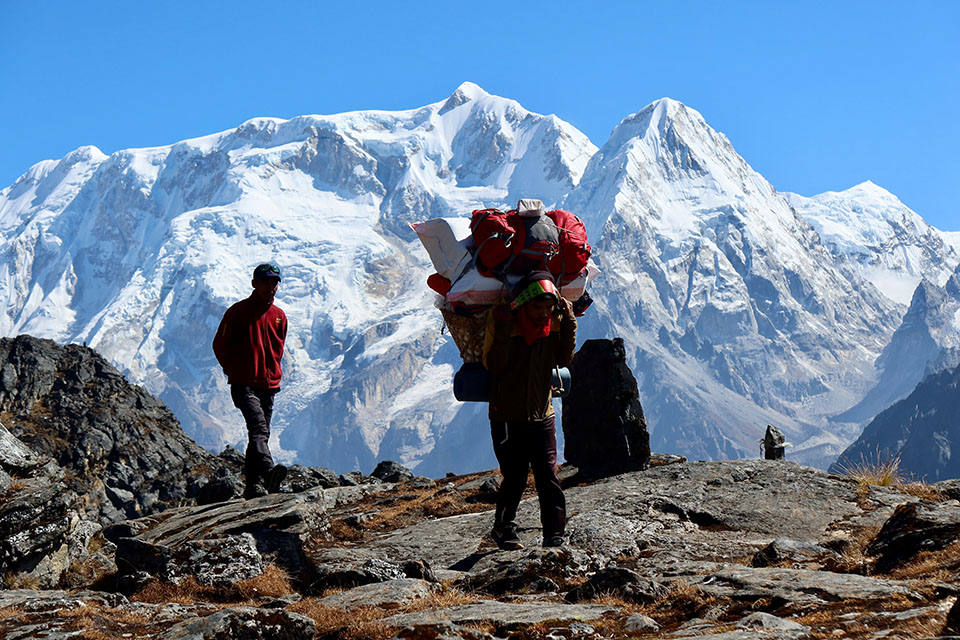
While crossing the Sinion La Pass, we had a stunning view of Rathong and Kabru IV in the background.
6. Renting Equipment and Gears for Kanchenjunga Base Camp Trek.
Essential Gear for Kanchenjunga Base Camp Trek:
The Kanchenjunga region is remote, high-altitude, and climatically sensitive, with parts reaching up to 5,150 meters. Proper trekking equipment ensures security, warmth, and comfort on the 26-day walk. It's not unusual for trekkers to rent or buy equipment in Kathmandu, especially that is used exclusively at high altitude.
Recommended Gear List:
- Sleeping Bag with a minimum of -30°C or colder (rental available in Kathmandu)
- A down jacket or an insulated parka for cold nights.
- Shell jacket and shell trousers (waterproof also).
- Base Layers (thermal top and bottom, 2–3 sets).
- Mid-layers like fleece jackets or insulated vests.
- Woolen hat, gloves, buff or scarf for the cold.
- Trekking poles (highly recommended for long ascents/descents).
- Headlamp with spare batteries.
- Daypack (20–30L) with rain cover.
- Porter-carried backpack or duffel bag (larger 80-100L).
- Hydration bladder or water bottles (2 liters' worth).
- Sunscreen and UV-protective sunglasses.
- Toiletries, personal medications, and a limited first aid kit.
Renting is budget-friendly and saves luggage space, especially for trekkers who do not want to carry heavy gear abroad. Visit Himalaya Treks can arrange equipment rental or provide some equipment as part of our deluxe service package to clients. Equipment may include trekking poles, a sleeping bag, a duffel bag, etc.
7. Miscellaneous Expenses on Kanchenjunga Base Camp Trek.
While your Kanchenjunga Base Camp Trek itinerary with Visit Himalaya Treks covers most major expenses like permits, lodging, meals, domestic flights, and guide/porter charges, there are some miscellaneous costs that you should be aware of and budget for during the trek. They are minor but add up, especially for a long 26-day trek.
Charging Electronics and Wi-Fi.
In far-flung Himalayan villages of the Kanchenjunga region, there is no adequate supply of electricity and sometimes generated by solar panels.
- Charging phones, cameras, and other gadgets usually attracts an extra cost of USD 2 to 5 per gadget per charge.
- Wi-Fi in the higher sections of the trek is limited. Internet facilities at lodges in villages like Taplejung or Ghunsa are available at USD 2 to 3 per hour, though connections are slow and inconsistent.
- It is convenient to carry a power bank or solar charger.
Hot Showers.
Basic tea houses during the trek may offer hot showers, especially at lower altitudes like Kanyam, Taplejung, or Ghunsa.
- The price is USD 3 to 5 for a shower.
- Above Ramche, Pang Pema, or Sele La altitudes, hot showers may be absent or bucket-heated.
- Day showers are shunned by most trekkers, and wet wipes and sponge baths are preferred.
More Snacks and Drinks.
Breakfast, lunch, and dinner are included in your trek package, but other snacks or beverages (apart from the normal meals) are at your expense.
- Chocolate bars, bottled water, soft drinks, tea, coffee, and instant noodles are easily accessible at an upgraded price at higher altitudes.
- Budget around USD 5 to 10 per day if you like extras between meals or would like to indulge in local sweets along the journey.
Emergency Expenses.
As the Kanchenjunga region is extremely remote, any type of medical emergency, altitude sickness, or injury can require helicopter evacuation, which would cost between USD 7,000 to 9,000.
- Make sure your travel insurance covers high-altitude trekking and emergency evacuation.
- You can also like to carry some extra money (approx. USD 200–300) to cover personal costs or change your itinerary if weather or logistics require. Souvenirs and Donations.
There are a few monasteries and village schools on the trekking path where you are received with small donations, and you might like to purchase some locally produced souvenirs from villagers to help the local economy.

Kumbhakarna (on the left) and Sobi Thongie (on the right) in the Kanchenjunga North Valley.
8. Cost-Saving Tips for Budget Trekkers.
Adopting the Kanchenjunga Base Camp Trek may prove to be expensive, given that it is remote and of longer length. However, with minimal planning and insight, budget trekkers can have it their way at a low cost.
Join Group Departures.
Another of the best cost-cutting strategies is to join a fixed group departure. Traveling in groups allows you to split the cost of services that are required, like guides, porters, and transport. Group travel also reduces the cost per person for logistics and permits, hence saving your money.
Rent Gear Instead of Buying.
Instead of purchasing brand-new trekking gear, hire necessary items like sleeping bags, down jackets, trekking sticks, or crampons from Kathmandu gear stores. It is very cost-effective and perfect for one-time or sporadic trekkers who don't want to splurge on gear.
Use Water Purification Methods.
Buying bottled water on the trail incurs a cost and also produces plastic waste. Bringing water purification tablets or a portable filter is a wiser, eco-friendly choice. Then you can safely drink freely available water in teahouses or from nature without spending extra money daily.
Limit Snacks and Extras.
Imported snacks, alcoholic beverages, and soft drinks are expensive on the trail as a result of transport costs. Carrying some of your own light snacks from Kathmandu can assist in reducing these daily expenditures. Hold to the teahouse meals that are typically part of the trek package.
Conclusion.
The Kanchenjunga Base Camp Trek is a once-in-a-lifetime journey in one of Nepal's most remote and culturally preserved Himalayan regions. While it is more expensive than other treks due to its limited access, longer duration on the trek, and logistical difficulty, the experience is well worth the investment. From serene forests to mighty mountains and secluded valleys, the trek offers unique natural splendor and cultural diversity.
On average, a well-planned trek costs you between $2,050 and $5,000, and it also varies with group size, season, services, and personal expenses. Knowing the causes behind the cost, from permit charges to guide service and accommodation, helps make better choices that are in your pocket.
At Visit Himalaya Treks, we have complete cost transparency. Our fully-inclusive Kanchenjunga Base Camp Trek package are designed to take care of everything from domestic flights and permits to food, accommodation, and experienced guide services. Whether you're a seasoned trekker or an adventure-first-timer, we're committed to delivering a safe, interactive, and value-for-money trekking experience.
